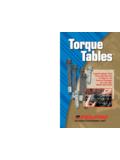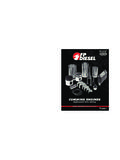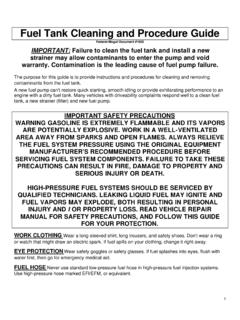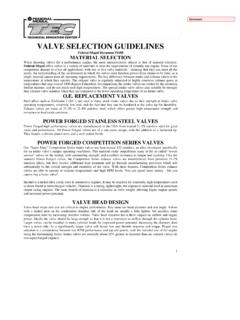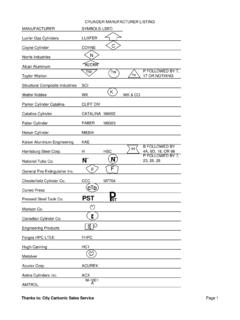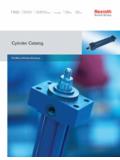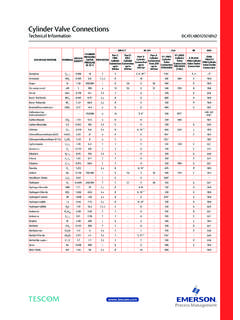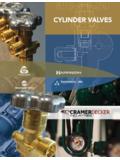Transcription of Cylinder Head Gaskets
1 Cylinder Head Gasket Installation Federal-Mogul Document #1425 Cylinder head Gaskets form the most critical seal on an engine - between the Cylinder head and the engine block deck. The head gasket must seal combustion pressures up to 1,000 psi ( kPa) in gasoline engines and 2,700 psi (1,862 kPa) in turbocharged diesel engines. In addition, the head gasket must withstand combustion temperatures that are in excess of 2,000 F (1,100 C). The head gasket also must seal coolant and hot, thin oil flowing under pressure between the block and head.
2 Modern coolant formulas and oil detergents and additives tend to cling to surfaces and soak into Gaskets . Gasket materials must be chosen carefully to resist these fluids and maintain an effective seal. Many head gasket coolant holes also meter the coolant flow to ensure proper circulation. Head Gaskets must resist the forces that tend to scuff gasket surfaces and inhibit proper sealing. One factor is engine vibration and head shifting and flexing that result from combustion pressures. Another factor is the differing expansion rates of bi-metal (aluminum head and cast iron block) engines.
3 Aluminum expands about twice as much as cast iron. The uneven expansion rates create a shearing action that the head gasket must accommodate. Head Gaskets also must resist crushing from Cylinder clamping forces that may be unevenly distributed across the head. These clamping forces run as high as 200,000 Ibs. (90,800 kg). Cylinder Head Gasket Designs Head gasket designs have changed over time, and in recent years are changing even faster. New engine designs and updates of "venerable" older engines require advanced materials and constructions.
4 Some new gasket designs may even be applied to older engines, so the head gasket you are replacing can look different from the one you used the last time. There are two things you should remember when selecting a head gasket. First, choose a high-quality manufacturer like Fel-Pro - one you can trust to assure that the engine will be sealed for a long time. 1 of 6 Second, there is no one best gasket design since no single type is best for all applications. Gasket manufacturers engineer the correct head gasket design for each individual engine.
5 Exhaustive testing is performed to ensure that the correct construction and design is used. Gasket designs that consumers receive are not necessarily at their option; they receive what is required by each application. No-retorque head Gaskets are now common and desirable. However, depending on the brand or design, many Gaskets for import vehicles, as well as older designs, require the Cylinder head to be retorqued. Retorque-type Gaskets take a set after initial engine operation and relax to the point where retorquing is needed to restore proper clamping force.
6 In the long run, the extra labor and expense of using a retorque Cylinder head gasket makes the repair more expensive than using a no-retorque design. Early Head Gasket Designs One early head gasket design was the Embossed Steel Shim. It was inexpensive to produce and used extensively by engine manufacturers. The design required supplementary sealers for an effective seal, but retained torque well. The problem with this gasket was that coolant could eventually corrode the steel, leading to gasket failure and possible engine damage.
7 Embossed steel shim Gaskets are not recommended for replacement use, as they may not effectively seal surface imperfections caused by engine wear. The soft Faced/Perforated Core head gasket was another early design. The gasket did not require supplementary sealers and the soft thick facing material would conform to surface irregularities. However, the soft facing material tended to compress and relax so that retorquing was necessary to maintain a good seal. Modern Head Gaskets Modern no-retorque head gasket constructions use a variety of materials and basically consist of facings, coatings and a core.
8 Cores can be either solid or clinched steel. Even if the core is a clinched steel type, the facing attached to it will be dense enough to maintain torque and strong enough to resist blowout. Two facing materials commonly used are expanded graphite and reinforced rubber fiber. These materials are dense enough not to relax much, so retorquing is not required; but, they will compress enough to conform to minor surface irregularities. This is important with smaller, higher-revving engines that are more subject to flexing and vibration.
9 Coatings are used as needed to help seal minor surface imperfections and resist friction. Coatings may be Teflon or silicone-based depending on the temperature range at which the engine will operate. A coating's anti-friction properties help the gasket deal with the shearing of facing material. Bi-metal engines' aluminum heads and cast iron blocks expand and contract at different rates during heating/ cooling cycles. This causes a shearing action that can eventually cause the gasket to degenerate and fail. Anti-friction coatings also act as anti-sticking agents so the Gaskets will come off clean, protecting the engine surfaces and reducing the labor required when serviced in the future.
10 Special Sealing Constructions As required, head Gaskets may utilize other special sealing constructions: Printoseal Elastomeric Sealing Beads increase clamping forces around critical sealing openings such as coolant and oil ports. It can be applied to several no-retorque designs. Printoseal also helps seal smaller displacement engines, such as newer domestic and imports, that are more subject to flexing. Wire Ring Combustion Seals may be encased in stainless steel armors for increased strength on racing and heavy-duty applications.
